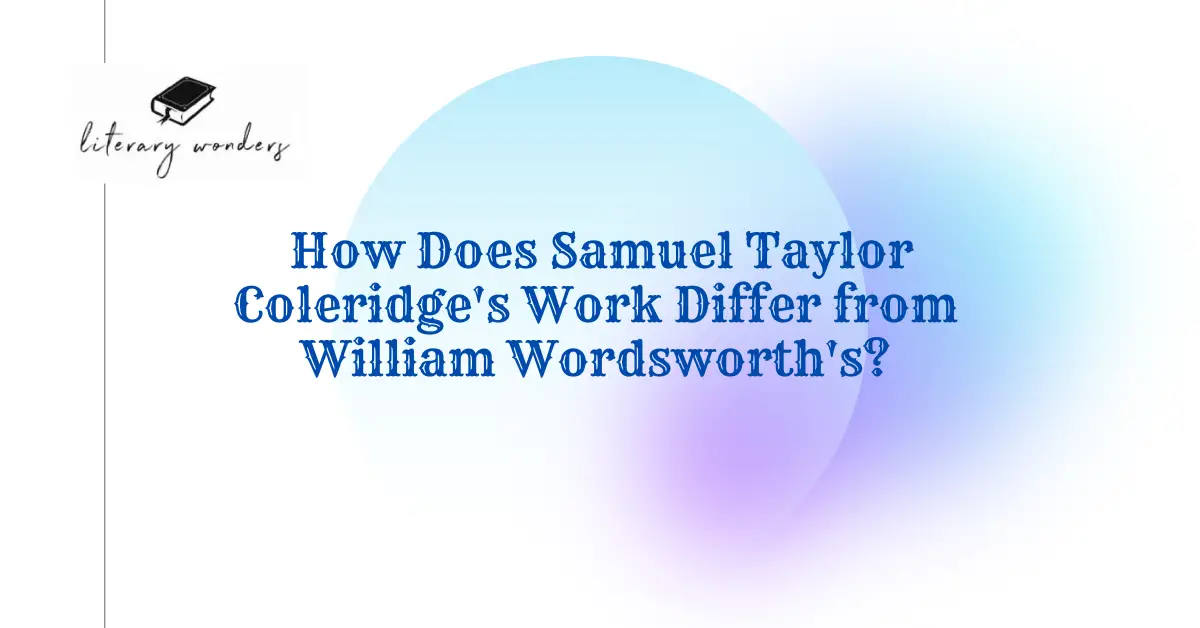Comparing Samuel Taylor Coleridge’s Work with William Wordsworth’s
The influential figures of the Romantic era, William Wordsworth and Samuel Taylor Coleridge, have had a lasting impact on the landscape of English literature. William Wordsworth, an influential figure in the realm of lyrical poetry, exalted the profound ability of nature to effect profound change.
Coleridge, via the utilization of enigmatic narratives, explored the domains of imagination and the supernatural. Collectively, they initiated a transformative movement in the realm of poetry.
While both eminent intellectuals exhibit shared subject elements and similar ideas in their literary works, their writings may identify discernible distinctions.
Although both poets demonstrate a profound admiration for the natural world and a defiant disposition towards societal conventions, their literary compositions manifest notable disparities in terms of thematic content, artistic techniques, and philosophical perspectives.
The following are discernible distinctions that can be readily observed in their respective works.
Nature as Inspiration
Both Samuel Taylor Coleridge and William Wordsworth assigned a significant role to nature in their poetic works, yet, their approaches and ideas diverged. William Wordsworth, sometimes credited as the initiator of the Romantic movement, expressed admiration for the tranquilizing influence of nature.
The author’s poetry, which includes pieces like “Lines Composed a Few Miles Above Tintern Abbey,” emphasizes the calming effect of nature on people’s cognitive and spiritual well-being. According to Wordsworth, nature is a catalyst for rejuvenating one’s spiritual self and a means to gain insight into the connection between individuals and a higher power.
In contrast, Coleridge used a spiritual and philosophical lens while engaging with nature. The poem titled “Rime of the Ancient Mariner” explores supernatural elements while exploring the concepts of culpability, redemption, and the incomprehensible within the context of the natural world.
Coleridge typically portrays nature in an ominous and enigmatic manner, emphasizing its potential to evoke unease and challenge human comprehension.
Imagination and Creativity
Another noteworthy characteristic is the divergence in the poets’ perspectives on imagination and creativity. Coleridge exhibited a profound interest in the dynamic relationship between fact and imagination.
The notion of the “willing suspension of disbelief,” as initially presented in his critical publication “Biographia Literaria,” delves into how art and poetry effectively captivate the reader’s imagination, enabling them to surpass the confines of reality. The aforementioned notion is evident in the author’s own creative and imaginative verses, shown by the poem “Kubla Khan,” in which he skillfully combines surreal and mythical imagery.
Wordsworth’s perspective on imagination was primarily rooted in the commonplace encounters of everyday existence. The individual believed that there was a profound interconnection between the faculty of imagination, the faculty of memory, and the capacity to discern the sublime within ordinary occurrences.
The author’s prioritization of the “authentic language of individuals” in the prologue of “Lyrical Ballads” underscores their objective of employing uncomplicated, approachable language to elicit profound emotions and realities.
Wordsworth’s poetic works frequently derive aesthetic pleasure and motivation from ordinary landscapes and individuals rather than depending on intricate imaginary frameworks.
Subjective vs. Objective
One notable disparity between the two poets resides in their respective approaches to their work’s subjective and objective aspects. Wordsworth’s poetic works are frequently distinguished by his subjective reactions to the natural world and the human condition.
The introspective nature of his poetry is evident in their reflection of his personal emotional responses and his examination of universally experienced human emotions. The presence of reflection is discernible in literary pieces such as “I Wandered Lonely as a Cloud,” whereby the author contemplates the emotional resonance evoked by a meadow adorned with daffodils.
In contrast, Coleridge often delved into the fantastical and supernatural domains, thereby creating a sense of detachment from direct personal expression. The poetry frequently incorporates characters and situations that present a difficulty to reasonable explication.
The poem “Christabel” incorporates spooky and gothic elements, skillfully crafting a narrative imbued with intrigue and magic. Coleridge’s examination of the supernatural exemplifies his propensity for engaging with the objective and imaginative domains of narrative.
Collaboration and Influence
The literary association between Coleridge and Wordsworth played a crucial role in influencing the development of their respective literary works. The joint endeavor undertaken by the authors of the “Lyrical Ballads” was a notable milestone within the context of the Romantic movement.
The collaborative publication sought to deviate from the dominant poetic conventions by centering its attention on commonplace subjects and the natural world. Nonetheless, the collaboration between Wordsworth and Coleridge also underscores their divergent approaches.
Wordsworth’s contributions tend to gravitate towards a more straightforward and easily comprehensible style, whilst Coleridge’s poems exhibit his subtle manipulation of language and contemplative reflections on philosophical matters.
Conclusion
In summary, the literary contributions of Samuel Taylor Coleridge and William Wordsworth serve as prime examples that showcase the multifaceted nature of the Romantic movement. Although both poets exhibited a fervent appreciation for the natural world and endeavored to express profound feelings via their poetry, their methodologies in terms of themes, imagination, subjectivity, and teamwork displayed notable disparities.
The proclivity of Coleridge towards the mystical and imaginative stands in stark contrast to Wordsworth’s emphasis on the remedial influence of nature and the efficacy of mundane encounters.
Collectively, the literary contributions of these authors enhance the intricate composition of Romantic poetry, with each individual adding a distinct element to the literary landscape of their era.
Suggested Readings
Analysis of “The Garden” by Andrew Marvel
How did William words worth organize “I Wandered Lonely as a Cloud” for readers?

